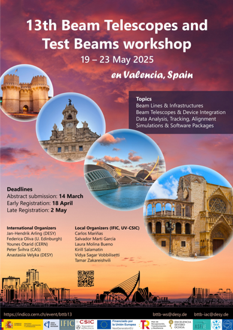Speaker
Description
The High-Luminosity LHC (HL-LHC) will deliver proton-proton collisions at 5 to 7.5 times the nominal LHC luminosity, with an expected number of 140 to 200 pp-interactions per bunch crossing. To maintain the performance of muon triggering and reconstruction under high background, the forward part of the muon spectrometer of the CMS experiment will be upgraded with Gas Electron Multipliers (GEM) and improved Resistive Plate Chambers (iRPC) detectors. A 6-layer Triple-GEM detector (ME0 station), covering about 60m2, will extend the pseudo-rapidity coverage of the muon system from |n|<2.4 to |n| <2.8 and will be installed behind the new high-granularity calorimeter (HGCAL) during the third Long Shutdown (LS3, 2026–2029). ME0 will be exposed to a background rate up to 150 kHz/cm2 and it required several design modifications. The design and performance under test with beams and irradiation at the GIF++ facility of a prototype 6-layer stack is discussed, and demonstrates that the prototype can operate in the challenging conditions of HL-LHC. Testbeam activities to test these chambers have started in 2021 and have continued up to 2024 and consisted both of tests at SPS with muons and at GIF++ under intense gamma irradiation. I will summarize the design changes the ME0 detectors underwent in the past years, together with all lessons learned from the continuous testing of the detectors, to finalize with a presentation of the measurement of their performance.
